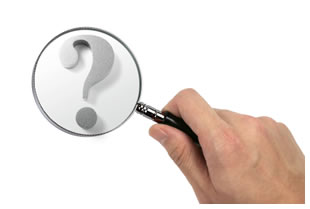Home > How to Present> Presentation Questions
Handling tough presentation questions posed by aggressive audience is a nightmare for most presenters. This usually adds to their fear of speaking.
You can deal them with poise, when you know how to categorize tough questions into one of the 5 common types.
Why does audience ask tough questions?
The reasons could vary from hidden personal agenda to low self esteem. No matter what reasons your audiences have for acting tough, their questions usually have certain common characteristics.

How to see it coming?
Usually tough presentation questions are preceded by a protective cushion statement.
The statement could be innocuous like –
With all due respect to you…or
You may be right, but…
Or it could be downright nasty, like – Considering your poor record in the past…
But, when you see a cushion statement coming, you know that a tough question is on its way.
The first task is to classify it…
The 5 common types of tough questions are:
1. General punch in the pain area
Usually these presentation questions have nothing to do with the topic of your discussion. The intention of the questioner is to use the public forum to throw a general punch in the pain area of the group. The main idea is to instigate a bitter debate in the crowd.
Example:
What do you think of the favoritism happening at the top level?
Warning:
The question is like a computer virus. When you click on it, you trigger untold damage.
Method to handle it:
Avoid the bait. Your answer could be in the lines of, “Since the question is not directly in the purview of our discussion topic, we will take that offline. Thank you for your participation. Is there any other question on what we discussed so far?”
Logic in the answer structure:
Notice that you didn’t thank the questioner for raising the issue, but thanked him for participating. You clearly mentioned that the question is out of the purview of discussion and asserted that you will take it offline.
To ensure that the discussion remains within the boundaries, you asked, “Is there any other question on what we discussed so far?”
Every sentence in the answer has a clear purpose and this usually puts the control right back in your hands.
2. Choose between devil and the deep blue sea
You are given two choices and you are trapped when you choose either of them. The questioner usually has a personal agenda and it is up to you to find the way out.
Example:
Do you care about achieving your team targets or about your team welfare?
Warning:
When you say, you care about your team targets; you get portrayed as a heartless leader running a slave ship. When you say, you care about your team welfare; you get portrayed as a weak leader with no goal orientation.
Method to handle it:
You don’t have to be restricted by the two options. Your answer could be in the lines of, “I care about both. Let us see how we can achieve both the ends for the benefit of our team.”
Logic in the answer structure:
By asserting to choose both the options you get the control in your hands. You may even choose an entirely new option. This puts the question in perspective and keeps you on track.
| Are you interested in sharpening your presentation skills by working with detailed examples and exercises?We recommend the Powerful Presentations Skills Training Video. Learn how to make remarkable presentations step-by-step and at your convenience. |
3. Can I shoot from your shoulder please?

Example:
What according to you will be our Director’s view on this debacle?
Warning:
Anything you say will be quoted and used against you. So, don’t fall into the trap.
Method to handle it:
You can’t be expected to answer on behalf of someone else. So, your answer could be, “It would be appropriate to ask the question to the Director herself. However, in my personal view…”
Logic in the answer structure:
By stating that you are not the right person to give someone else’s view you avoided the trap. By providing your personal view, you showed that you are in control.
4. The loaded gun
This is usually an allegation in the garb of a question. The questioner wants to accuse you of something. The accusation is cleverly hidden as a question to seek the crowd’s approval. Unless you are watchful, you’ll get trapped in this.
Example:
Considering you couldn’t handle your team too well last year, can we expect to see any improvement this time?
Warning:
If you haven’t noticed yet, this is an allegation and not a question. With this presentation question, the questioner wants to tell the crowd that it is you who is responsible for the team’s poor performance last year.
If you simply begin listing your initiatives for this year, you imply that you didn’t handle your team well last year, which may not be the case in reality.
Method to handle it:
Isolate the allegation and handle it squarely. Your answer to this presentation question could be, “If I understand you correctly, you assumed that I was responsible for the team’s poor performance last year. May I know why you made that assumption?”
Logic in the answer structure:
By isolating the assumption you stopped the questioner in the tracks. By inviting an explanation for the assumption you created a chance for yourself to explain your view. This disarms the questioner and helps you win the trust of the crowd.
5. Imaginary question
This question is aimed to expose your lack of preparation. The questioner wants to hog the limelight by putting you in a spot.
Example:
“If the regulations were to change tomorrow, how will we respond to the issues that arise?”
Warning:
You can’t disregard the question. It will make it seem like you lack foresight.
Method to handle it:
Draw the attention to the assumption. Your answer could be in the lines of “Is there any specific reason why you believe that the regulation will change in the immediate future?”
Logic of the answer structure:
The answer is structured as a question. This puts the ball right back in the questioner’s court. If there is credence to the assumption, everyone gains. If there is no base behind the assumption, it puts the control back to you.
Now, you learnt the process of handling tough presentation questions.
Let us make it clear that 99% of your audience ask questions, either to seek information or to seek reassurance from you.
All we discussed in this article is about that rare 1% of the audience who can undermine your confidence as a presenter.
Do you know what your presenter personality type is? This will also help you understand your strengths and action points as a presenter.
Thumb rule for presentation questions…
…the two questions you need to ask yourself when you hear a cushion statement followed by a question is…
- Is the question relevant to the topic of discussion?
- Is there any assumption made in the question?
The answers will guide you in the way forward.
If you had followed the Minimal® process for creating your outline you can anticipate most of the genuine questions that may arise in your presentation.
You gain additional confidence to handle audience by having strong visual slides that sell.
That is all the preparation you need.

